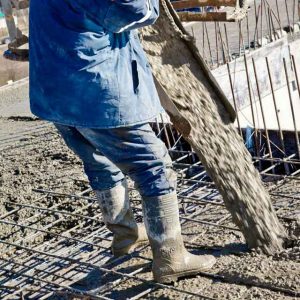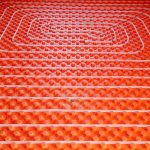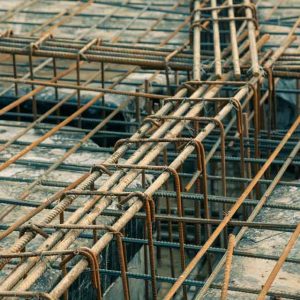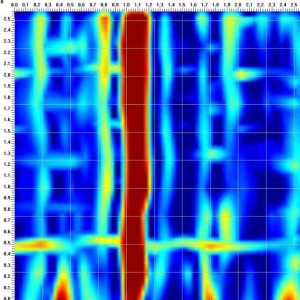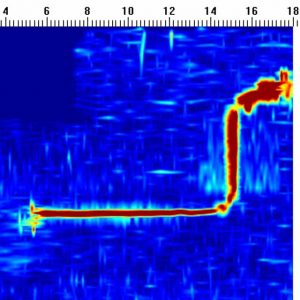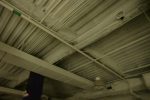GPR Concrete Scanner and 3-D Imaging Services NDT
GPR Concrete Scanning Services for Nondestructive Testing
Like X Ray, GPR concrete scanner images post tension cables, conduit, pipe, wire, rebar, voids, mesh, tubing, and concrete thickness, to name a few features.
In short, concrete scanning equipment uncovers and reveals what is inside a concrete slab by plotting 2-D and 3-D images or maps. A collection of 2-D GPR scan lines from grids with parallel and perpendicular lines create 3-D images of the interior of a concrete slab. Each scan line produces a single cross-section. The plan view color maps are created by gathering adjacent cross-sections and processing these ground penetrating radar ( GPR ) results in to a plan view diagram. These plots provide a record for immediate use or historical archive. GPR concrete scanning equipment can penetrate about two feet of concrete and is safe, unlike the nuclear radiation from X-ray sources.
Find an experienced concrete scanner.
Given an operator with experience and a reasonable level of effort, concrete scanning works extremely well. There are few alternatives that characterize the interior of a concrete slab as well as a GPR. Geophysical Services LLC, a professional geophysical consulting company (since 1985) owns and operates ground penetrating radar to characterize and image concrete. The company’s service area covers the Midwest and includes cities like Chicago, Milwaukee, Madison, Green Bay, Marinette, Beloit, Minneapolis, La Cross, Rockford, Wausau, Marquette. The cost of the professional concrete scanning services are reasonable and competitive.
Unlike some of the competitors, the company’s equipment can scan entire rooms, as well as small isolated areas. The concrete scanning services have successfully imaged difficult targets like concrete bolts used to fasten corrugated metal decking to I-beams, plastic pipe or braided PVC tubing covered with concrete, voids, cracks, and under good conditions sewer waste lines beneath a gravel base. Most of the time, the services are requested to locate or image post-tension cables, pipe, conduit, wiring, and re-bar.
In one case history, nearly 60 core holes, for decorative lighting, were being installed in an observation platform. The approximately 7 by 7 foot area was constructed with very closely spaced metal re-bar. With the exception of two holes that cut through the re-bar on purpose, the re-bar was not damaged and the integrity of the concrete slab remained intacted. With over 30 years of field experience with sophisticated electronics, the concrete scanners are well maintained, which leads to less down time.
What is a concrete scanner or what is concrete scanning?
Professional concrete scanners use ground penetrating radar or GPR technology. GPR equipment transmits an electromagnetic pulse that is reflected or returned back by an object. The reflections from targets within a concrete slab map or image the concrete slab, much like a fish locator bounces a signal off of fish or a lake bottom. Undoubtedly locating, finding, or detecting post tension cables, conduit, wires, reinforcing bars (rebar), metal pipes, plastic tubing, PVC pipe, voids, cracks, wire mesh, and precious metals (gold and silver) requires a formal systematic approach.
In many cases, concrete scanning can image these features inside other materials like pavement, wood, asphalt, rock, and ice. X-ray scanning or a small handheld scanners are available. However, lesser methods seldom replace the functionality of a GPR concrete scanner. Follow this link to find out more about the theory and physics behind a GPR concrete scanner or follow this link to contact a concrete scanner located in Wisconsin, Illinois, Michigan, Indiana, Iowa, or Minnesota.
Why use GPR to scan concrete slabs.
In other words, what is the difference between GPR and other none destructive testing ( NDT ) equipment.
There are several options available in today’s market. To name a few, there are X-ray methods, small hand held construction grade concrete detectors, thermal imaging cameras, and re-bar detectors. The first and most obvious difference is price. X-ray instruments and GPR concrete scanning equipment costs nearly 10 to 30 times more to purchase than thermal imaging equipment or construction grade concrete detectors.
Obvious benefits of GPR
To delineate or define a feature within a concrete slab is sometimes a difficult task. In my opinion, the key to reaching a higher level of confidence is the ability to create a map or an image of the area of concern. Following the response shown in a small two inch LCD display can deceive the minds’ eye. Formally mapping an area of concern with a GPR concrete scanner increases a concrete cutter’s or other professional’s confidence that they located a facility, a post tension cable, or other reinforcing material and know it is not likely a false indication.
A plan view map or an X-ray is a permanent record. Consequently, there is documentation that demonstrates why it appeared to be appropriate to penetrate the concrete slab where it was marked. Furthermore if a mistake is made, it demonstrates that the people who cut or penetrate the slab did not follow directions or made a mistake in determining the correct location. Sometimes the inconvenience of moving to the correct location to penetrate the concrete slab may compromise a cutters’ better judgement.
In my opinion, less expensive methods are not able to detect non-metallic features at depth as well as the more sophisticate instrumentation. Scanning for non-metallic targets is a difficult task and often requires sophisticate technology that costs more than a few hundred dollars. Above all, the depth of penetration for GPR is up to about 24 inches. In comparison, less expensive instruments have a depth of penetration on the order inches.
GPR concrete scanners have advantages over X-ray methods.
Certainly one of the most obvious difference between ground penetrating radar and X-ray is safety. As its name suggests, X-ray methods use radioactive material. The radiation exposes the film, much like it does in the medical industry. As a result, the general public, employees, or other non-essential personnel must not be in the vicinity of the X-ray radiation. This is often difficult to do during normal business hours. For safety reasons, it may be necessary to clear the region on both sides of the concrete slab when there is a radioactive source in the area. This may mean the area above and below a concrete floor or on both sides of a concrete wall may not be available for daily operations. In comparison, GPR only needs access to only one exposed face of the concrete slab.
There are other benefits. Because GPR transmits a safe electromagnetic pulse, there are no demanding regulations (other than the FCC) to limit its operation. The FCC regulations are typical for devices, like radios, that transmit signals that can interfere with wireless communications. To demonstrate its safe application, it is unlikely that airports or hospitals would allow concrete scanning surveys, if the GPR signal could harm people or interfere with nearby sensitive electronics.
Size and depth.
Unlike x-ray, where the area imaged is restricted to the size of a sheet of film, higher end GPR concrete scanners are capable of scanning very large areas. With these systems, there are few limitations on how large of an area can be imaged. One of the finial benefits of using a concrete scanner is its real time estimate of depth. Depth estimates are often a concern, especially when professionals want to differentiate between targets. Plan view plots of facilities from various depths helps determine the continuity between features. For example, plan view plots in one inch or half inch increments in depth demonstrate the relative elevation of a facility, PT cable, or other target. It can show if a facility or reinforcing material is near the surface or near the bottom of the slab.
Does GPR concrete scanning work?
Absolutely. Good quality instruments are built by electrical engineers who understand the laws of physics. Concrete scanners operating per the manufactures recommendations generally perform as specified. In my opinion, anyone who is disappointed often believes the equipment is more or less a crystal ball. It is a sophisticated piece of equipment that is constrained by the laws of physics. Furthermore, failure is bound to occur at some point when cost is more important than the level of effort put into the survey. I often hear, how fast can you scan the concrete. We want to cut the concrete in the next hour or so. You get what you pay for.
Concrete scanners may not produce desirable results everywhere.
While the signal from a scanner will not penetrate surfaces covered by metal, characterizing corrosion, accurately measuring the diameter of metal rods or re-bar, detailing the top and bottom of a void, and mapping cracks can be beyond the available technology or the laws of physics. Due to the moisture or the ability of uncured concrete to conduct electricity, the GPR signal does not pass through these materials very well or not at all. It is best to scan the concrete after it has had time cure. Furthermore one should also know that characterizing the extent of corrosion is not easy to observe. The greater the degree of corrosion the more likely an interpretation will correctly find areas of concern.
Professionals should be aware that layers of construction materials (for example, Styrofoam sheets or built of layers of wood) effectively create a gap between the bottom of the concrete scanner and the face of the concrete surface. Thick layers of wood or foam, more or less, act like an air gap, which is much greater than a rough or uneven surface. It is much like sliding the concrete scanner above a concrete slab with the scanner an inch or so away from the surface of the slab.
Voids are difficult to characterize.
Finally, locating a void beneath the surface of a concrete slab or immediately beneath the slab is easier to do than determining the thickness of a void. This has to do with changes in the velocity of the GPR signal and how the signal continues to propagate after it encounters a void. The response can be very complex. In fact, this is one of the reasons it is also difficult to image the region adjacent to the hollow spaces in concrete blocks or hollow core precast concrete. The solid mass between the hollow spaces in block and precast concrete is more likely to produce desirable results.
In Fromm Applied Technology’s opinion
Desirable concrete scanning has to do with the personal approach of the concrete scanner.
Undoubtedly, we have available to us today some of the greatest geophysical instrumentation ever manufactured. A geophysicist or concrete scanner needs to design his ground penetrating radar surveys around the site conditions and the clients level of confidence. For the concrete scanner to deliver desirable results, the client needs to understand and accept that the laws of physics apply to concrete scanning. Then and only then will geophysical non-destructive testing, such as GPR, assist a concrete scanner and client with locating private facilities, measuring concrete thickness, locating post tension cables, finding voids, locating plastic or PVC pipe, and finding re-bar.
A message to estimators and those who write proposals.
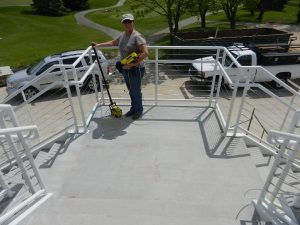
Without doubt, concrete scanning with GPR works very well. When preparing a bid or responding to a quote requiring a concrete scanner be careful who or what you ask for. So, you are in the process of creating a budget for a future project. Therefore, make sure in your search for concrete scanners that you find someone who provides cost effective services and offers a reasonable level of due diligence. Moreover, a concrete scanner who provides professional services, often directly to architects, engineers, and upper management, is not usually a full time concrete cutter or trades person.
Do not under estimate the necessary level effort.
I found over the years that concrete scanners fall into two general groups. The first group provides concrete scanning as professional services and charge $1000 to $2000 per day per concrete scanner. While these professionals are able to supply diagrams for immediate use, as a deliverable they generally provide a written report with colored graphics. The second group of concrete scanners generally provide services to supplement or perpetuate their primary business, concrete cutting or construction services. Since their primary business is often in the trades they charge $300 to $500 per day to secure the project. Often this group interprets basic cross sections and does not create 3-D images of the scanning results. As a result, they depend on interpreting 1-D scan lines that can be overwhelming to the mind’s eye.
Case in point.
Don’t get me wrong, I am certain this second group of concrete scanners are good people with good intentions. However, their company’s primary concern is how fast can they get approval from a project manager or supervisor to cut the concrete. I have seen contractors cut through marked lines. There are some (not all) who’s only concern is to come in cut and install new supply lines, heating lines, electrical lines, DWV lines, or pour a new slab. I do not think this is due diligence. When something is hit, they commonly fall back on the argument that there are not any guarantees in concrete scanning. This mind set leads to the customer saying GPR doesn’t work and has the tendency to undermine the credibility of GPR concrete scanning. GPR works.
To Illustrate my opinion further, review the typical fees charged for professional services in general. Throughout many industries here are few professional services that have an average cost of less than $1800 per day (or roughly $900 per half day). One needs to ask why doesn’t the 2nd group charge these rates? In my opinion, it is because they are making their money on other items in the project. Offering concrete scanning is a way to get the contract. I am not sure that engineers, architects, project managers, and building owners and operators would appreciate this approach, especially, after something is damaged.
Finally, search other internet sites that offer concrete scanning services. Take a look at their content. Many of the sites that offer concrete scanning at the lower rate offer little information about concrete scanning. Consequently, there may be a correlation with the services they provide. While this may be an overstatement of the types of concrete scanners and services, I am certain that this discussion rings true for those of you who have been there and done that. Follow these links to better understand the theory behind ground penetrating radar concrete scanning.
Ask before you contract.
Does the concrete scanner have experience? Is he or she a geophysicist, engineer, or other type of professional?
For your next survey
Contact: Fromm, Arthur-Licensed Professional Geologist/Geophysicist-Started 1985-Conducted over 900 geophysical surveys.
Where can I find a concrete scanner?
Regionally, concrete scanning services are available in Wisconsin, Illinois, Michigan, Indiana, Minnesota, and Iowa. Find a concrete scanner that services local ares in your vicinity
Milwaukee
Green Bay
Madison
Appleton
La Crosse
Beloit
Superior
Platteville
Wausau
Chicago
Rockford
Waukegan
Peoria
Champaign
Springfield
Kankakee
Bloomington
Joliet
Aurora
Marquette
Escanaba
Menominee
Iron Mountain
Sault Ste. Marie
Houghton
Grand Rapids
Mackinaw City
Marinette
Traverse City
Kalamazoo
Indianapolis
Gary
South Bend
Lafayette
Fort Wayne
Michigan City
Terre Haute
Minneapolis
St. Paul
Rochester
Duluth
Iowa
Dubuque
Clinton
Davenport
Prairie du Chien
